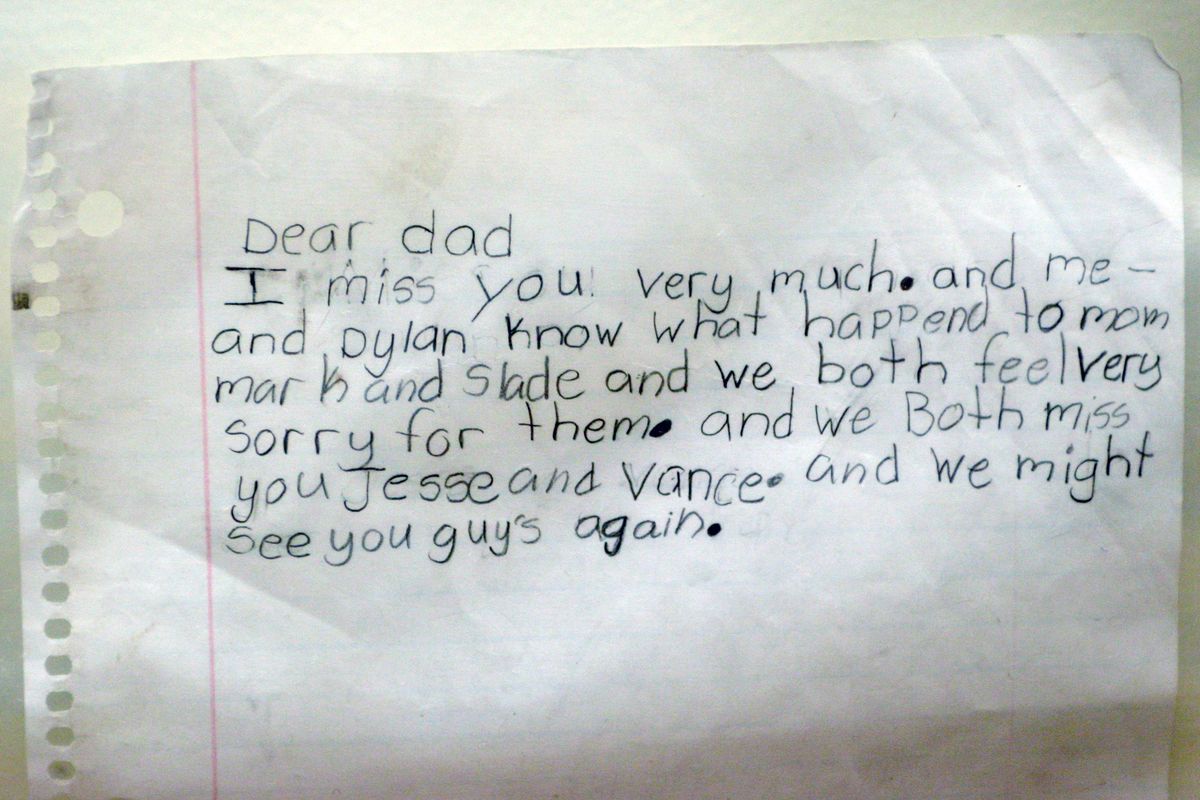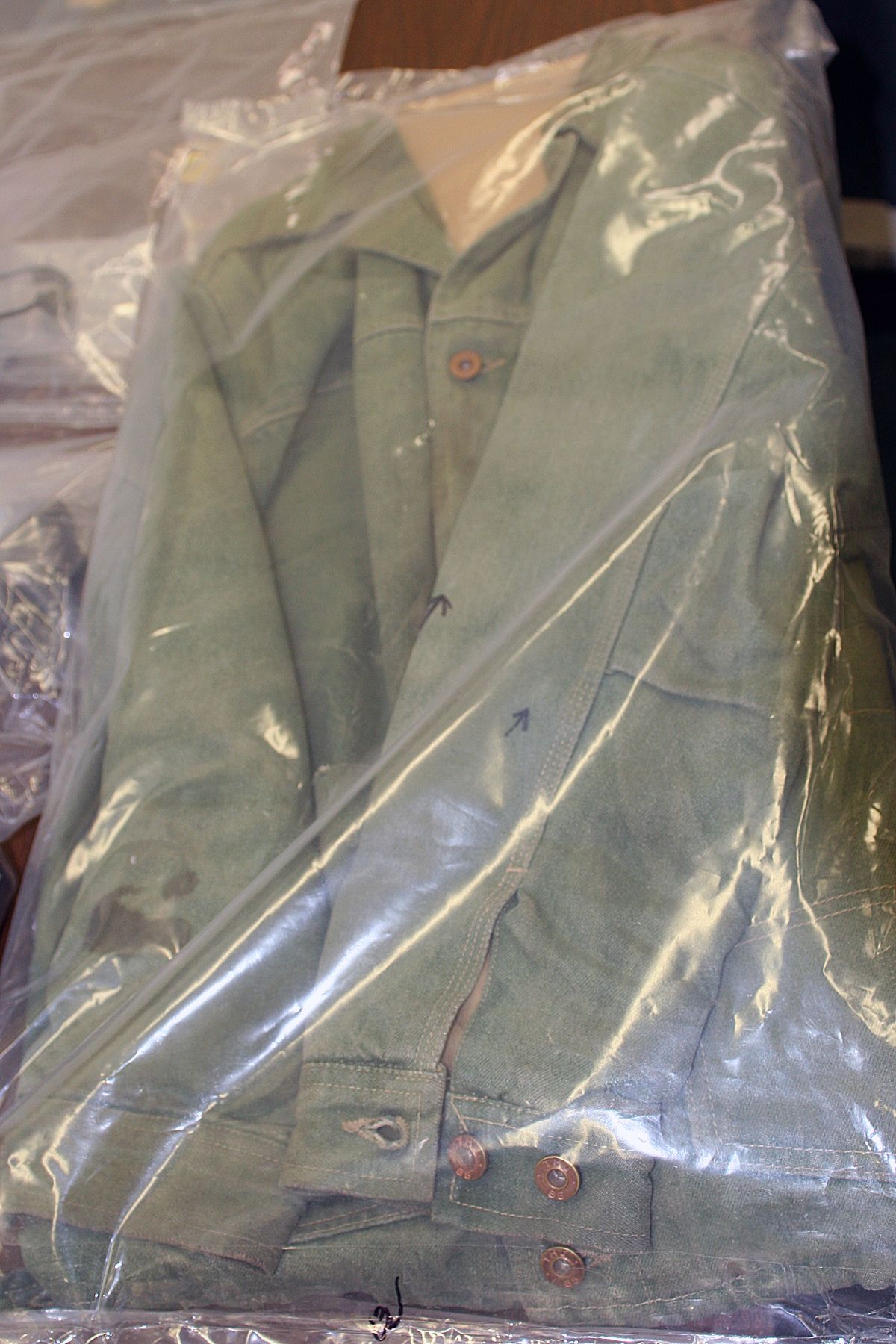Details revealed in tape of Shasta
Children believed they’d go home
One of four letters introduced into evidence Thursday. Steve Groene, father of Dylan and Shasta, said he never received them.Steve Conner Photography (Steve Conner Photography / The Spokesman-Review)
BOISE – One of the big mysteries surrounding Joseph Duncan’s murderous crime spree three years ago was resolved Thursday as the frightened, tearful voice of an 8-year-old girl explained to rescuers why after nearly two months of captivity her abductor had brought her back.
“He was going to take me home,” Shasta Groene told Coeur d’Alene police Officer Shane Avriett in an audio recording from July 2, 2005, that was played for jurors deciding whether Duncan should be executed or sentenced to life in prison.
“What made him change his mind?” Avriett asked her as the video camera in his police cruiser recorded their conversation outside a Coeur d’Alene restaurant where employees had recognized Shasta from police posters and called authorities.
“He was going to change his mind,” the girl explained before breaking into a sob, “because he said that I taught him how to love.”
Duncan, 45, is facing the death penalty in U.S. District Court at Boise for the torture and murder of Shasta’s 9-year-old brother, Dylan, who documents show also was under the impression that he would be freed but was instead shot to death at a campsite in front of his sister. Duncan already has pleaded guilty to state charges for killing three members of the Groene family in a bloody attack in order to get to the children. Shasta, now 11, was the only survivor.
The playing of the audio to a stunned, silent courtroom capped an emotional day in Duncan’s death penalty sentencing trial, while providing numerous never-before-released details about the case.
Early on, police asked Shasta where her brother was. “In heaven,” she responded, breaking into tears. When the officer asked again if she knew where her brother was, Shasta said, “There may be some evidence down in the Lolo Forest, because that’s where we were.”
Shasta described for the officer how the man she was with shot her brother in the abdomen while she watched. He then shot the boy again in the head, point-blank, killing him.
Later on the tape, Avriett asked Shasta, “What’s his name?”
“Jet Duncan,” she responded.
Duncan went by a nickname, Jet, short for his full name of Joseph Edward Duncan III.
Earlier, letters from both Shasta and Dylan written during their captivity were introduced into evidence, and the children’s father, Steve Groene, was called as a witness to identify his children’s handwriting.
Three of the letters were written to him, but Groene told the court he never received them. They were seized from the 2005 red Jeep Grand Cherokee Laredo Duncan was driving when he kidnapped the children from their home east of Coeur d’Alene and later when he was arrested.
The notes included one that began in large letters, “DEAR SHASTA, I started to cry when I saw other people. So God told Jet to let me go home to Dad. I will tell Dad that you are OK.” The second letter began, “Dear Dad, I miss you very much.” The third began, “Dear Dad, this is Dylan. We are still alive. We are OK. We know what happened to Mom.” The fourth began, “Dear Dad, I have some very good news and it is we are coming home soon!” Sadly for Dylan, that never happened.
Also introduced into evidence in court Thursday were numerous items seized from Duncan’s SUV, including Duncan’s green Tommy Jeans jacket with bloodstains containing Dylan’s DNA, a laptop computer with a “Blues Brothers” sticker on it proclaiming “I’m on a mission from God,” and a GPS unit. Wednesday, in his opening statement, U.S. Attorney Tom Moss said the jacket has blood from both Dylan and Shasta on it. It was found on the passenger seat of the Jeep.
Coeur d’Alene Denny’s Manager Linda Barger was among seven witnesses called to testify Thursday. She told of how she was working a graveyard shift on July 2, 2005, when Duncan came into the restaurant with a little girl about 2 a.m. She and others thought the child looked like Shasta, whose picture was emblazoned on posters that had been posted at the restaurant.
The girl was filthy, with uncombed hair and light clothing. “That’s what caught our eye,” Barger told the court. “She was in shorts and a little shirt, and she looked like a child that had been playing in dirt all day.”
Barger said she asked employees to guard a back door and had a waitress try to delay the pair while she went to the back to call police. “I called 911 and told them I was 99.99 percent thinking it was her,” Barger said. “By that time, one of my servers had laid the picture in front of me, and I said, ‘It’s her, get over here.’ ”
Duncan, who is acting as his own attorney, raised no objections to any of the evidence and asked only a few questions when it was his turn to cross-examine the witnesses.
He asked FBI Special Agent Mike Gneckow of Coeur d’Alene to rewind back to the final frame of a surveillance video from a Kellogg convenience store that Gneckow had just narrated. It showed Duncan and Shasta stopping at the Conoco store about five hours before Shasta’s rescue. At one point, a police car cruises down the street as Duncan fills the Jeep with gas.
“I saw it even now,” Duncan said. “In that last frame, there’s another police car that comes around the corner – do you have any knowledge of that?” Duncan asked Gneckow. Gneckow looked confused; no second police car was readily visible on the screen. “I just wondered if you were aware of that,” Duncan said to Gneckow. “I was not aware of that, no,” Gneckow responded.
Duncan also questioned Barger, asking her why, when he and Shasta ordered a milkshake, the waitress delivered a metal cup with additional milkshake in it, in addition to the milkshake glass. “Exactly – that’s how we serve a milkshake,” she responded.
“I’m just clarifying this stuff, just for the record,” Duncan said.
The testimony also included detailed accounts from law enforcement officers of the first three murders and how Duncan committed them. When federal prosecutors tried to show jurors photos of the bloody bodies found in the Groene family home, U.S. District Judge Edward Lodge sent the jury out of the room.
“This is not the counts we’re dealing with, the death of D.G.,” the judge told the prosecutors. An appeals court likely would find the graphic photos “unduly prejudicial” if they’re shown to the jury, he said.
Assistant U.S. Attorney Wendy Olson argued that the previous murders are an aggravating factor in arguing for the death penalty for Duncan’s later murder of Dylan, and that the photos prove his violent intent toward Dylan by showing how violently he’d entered the family’s home to get at the youngest children. But Lodge said the murders can be adequately described and proved. “For the sake of avoiding error, this case can be presented … without actually showing these photos to the jury,” he said.
The sentencing trial continues with more witnesses today; federal prosecutors said they plan to call about 90 witnesses, and the case could take four to six weeks.

